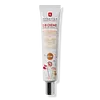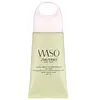What's inside
What's inside
 Key Ingredients
Key Ingredients

 Benefits
Benefits

 Concerns
Concerns

 Ingredients Side-by-side
Ingredients Side-by-side

Water
Skin ConditioningCyclomethicone
EmollientGlycerin
HumectantTitanium Dioxide
Cosmetic ColorantPEG-10 Dimethicone
Skin ConditioningDipropylene Glycol
HumectantEthylhexyl Methoxycinnamate
UV AbsorberDimethicone
EmollientTalc
AbrasiveIsoeicosane
EmollientZinc Oxide
Cosmetic ColorantHexyl Laurate
EmollientDisteardimonium Hectorite
StabilisingBetaine
HumectantPanax Ginseng Root Extract
EmollientGlycyrrhiza Glabra Root Extract
BleachingPortulaca Oleracea Extract
Skin ConditioningDioscorea Villosa Root Extract
Skin ConditioningEquisetum Giganteum Extract
Skin ConditioningKigelia Africana Fruit Extract
Skin ConditioningHydrogenated Starch Hydrolysate
HumectantEthylhexylglycerin
Skin ConditioningTocopheryl Acetate
AntioxidantMagnesium Sulfate
Silica
AbrasiveGlycosyl Trehalose
Emulsion StabilisingAluminum Hydroxide
EmollientPalmitic Acid
EmollientStearic Acid
CleansingPhenoxyethanol
PreservativeButylene Glycol
HumectantAcrylates/Dimethicone Copolymer
Skin ConditioningDimethicone/Vinyl Dimethicone Crosspolymer
Skin ConditioningMethicone
EmollientVinyl Dimethicone/Methicone Silsesquioxane Crosspolymer
Parfum
MaskingAlpha-Ionol
PerfumingIsomethyl-Beta-Ionone
PerfumingHexyl Cinnamal
PerfumingLinalool
PerfumingCitronellol
PerfumingGeraniol
PerfumingEugenol
PerfumingLimonene
PerfumingCI 77492
Cosmetic ColorantCI 77499
Cosmetic ColorantCI 77491
Cosmetic ColorantWater, Cyclomethicone, Glycerin, Titanium Dioxide, PEG-10 Dimethicone, Dipropylene Glycol, Ethylhexyl Methoxycinnamate, Dimethicone, Talc, Isoeicosane, Zinc Oxide, Hexyl Laurate, Disteardimonium Hectorite, Betaine, Panax Ginseng Root Extract, Glycyrrhiza Glabra Root Extract, Portulaca Oleracea Extract, Dioscorea Villosa Root Extract, Equisetum Giganteum Extract, Kigelia Africana Fruit Extract, Hydrogenated Starch Hydrolysate, Ethylhexylglycerin, Tocopheryl Acetate, Magnesium Sulfate, Silica, Glycosyl Trehalose, Aluminum Hydroxide, Palmitic Acid, Stearic Acid, Phenoxyethanol, Butylene Glycol, Acrylates/Dimethicone Copolymer, Dimethicone/Vinyl Dimethicone Crosspolymer, Methicone, Vinyl Dimethicone/Methicone Silsesquioxane Crosspolymer, Parfum, Alpha-Ionol, Isomethyl-Beta-Ionone, Hexyl Cinnamal, Linalool, Citronellol, Geraniol, Eugenol, Limonene, CI 77492, CI 77499, CI 77491
Cyclopentasiloxane
EmollientSd Alcohol 40-B
AstringentGlycerin
HumectantMethyl Methacrylate Crosspolymer
Dimethicone
EmollientPEG-10 Dimethicone
Skin ConditioningPolybutylene Glycol/PPG-9/1 Copolymer
Skin ConditioningLauryl PEG-9 Polydimethylsiloxyethyl Dimethicone
Skin ConditioningPolymethylsilsesquioxane
Talc
AbrasiveErythritol
HumectantSilica
AbrasiveTrehalose
HumectantDisteardimonium Hectorite
StabilisingTrimethylsiloxysilicate
EmollientCaffeine
Skin ConditioningBetaine
HumectantPEG/PPG-17/4 Dimethyl Ether
Skin ConditioningPhytosteryl/Octyldodecyl Lauroyl Glutamate
Skin ConditioningDipeptide-15
Skin ConditioningEriobotrya Japonica Leaf Protoplasts
AntioxidantPaeonia Albiflora Root Extract
Skin ConditioningLamium Album Flower/Leaf/Stem Extract
Skin ConditioningCitrus Junos Seed Extract
AntioxidantEriobotrya Japonica Leaf Extract
Skin ConditioningAluminum Hydroxide
EmollientStearic Acid
CleansingIsostearic Acid
CleansingButylene Glycol
HumectantTrisodium EDTA
Polyester-1
Alcohol
AntimicrobialSilica Dimethyl Silylate
EmollientAlumina
AbrasiveTriethoxycaprylylsilane
Hydrogen Dimethicone
BHT
AntioxidantTocopherol
AntioxidantPhenoxyethanol
PreservativeBenzoic Acid
MaskingParfum
MaskingTitanium Dioxide
Cosmetic ColorantIron Oxides
Mica
Cosmetic ColorantCyclopentasiloxane, Sd Alcohol 40-B, Glycerin, Methyl Methacrylate Crosspolymer, Dimethicone, PEG-10 Dimethicone, Polybutylene Glycol/PPG-9/1 Copolymer, Lauryl PEG-9 Polydimethylsiloxyethyl Dimethicone, Polymethylsilsesquioxane, Talc, Erythritol, Silica, Trehalose, Disteardimonium Hectorite, Trimethylsiloxysilicate, Caffeine, Betaine, PEG/PPG-17/4 Dimethyl Ether, Phytosteryl/Octyldodecyl Lauroyl Glutamate, Dipeptide-15, Eriobotrya Japonica Leaf Protoplasts, Paeonia Albiflora Root Extract, Lamium Album Flower/Leaf/Stem Extract, Citrus Junos Seed Extract, Eriobotrya Japonica Leaf Extract, Aluminum Hydroxide, Stearic Acid, Isostearic Acid, Butylene Glycol, Trisodium EDTA, Polyester-1, Alcohol, Silica Dimethyl Silylate, Alumina, Triethoxycaprylylsilane, Hydrogen Dimethicone, BHT, Tocopherol, Phenoxyethanol, Benzoic Acid, Parfum, Titanium Dioxide, Iron Oxides, Mica
 Reviews
Reviews

Ingredients Explained
These ingredients are found in both products.
Ingredients higher up in an ingredient list are typically present in a larger amount.
Aluminum Hydroxide is a form of aluminum. It can be naturally found in nature as the mineral gibbsite. In cosmetics, Aluminum Hydroxide is used as a colorant, pH adjuster, and absorbent.
As a colorant, Aluminum Hydroxide may add opacity, or reduce the transparency. Aluminum hydroxide is contains both basic and acidic properties.
According to manufacturers, this ingredient is an emollient and humectant. This means it helps hydrate the skin.
In medicine, this ingredient is used to help relieve heartburn and help heal ulcers.
There is currently no credible scientific evidence linking aluminum hydroxide in cosmetics to increased cancer risk.
Major health organizations allow the use of aluminum hydroxide in personal care products and have not flagged it as a carcinogenic risk at typical usage levels.
Learn more about Aluminum HydroxideBetaine is a common humectant (a substance that promotes retention of moisture). It's known to be gentle on the skin and can help balance hydration.
This ingredient is best for improving hydration and soothing irritated skin. Studies also show it helps even out skin tone.
Fun fact: Betaine is naturally created in the skin and body. The kind found within cosmetic products can be either plant-derived or synthetic.
Another name for betaine is trimethylglycine.
Learn more about BetaineButylene Glycol (or BG) is used within cosmetic products for a few different reasons:
Overall, Butylene Glycol is a safe and well-rounded ingredient that works well with other ingredients.
Though this ingredient works well with most skin types, some people with sensitive skin may experience a reaction such as allergic rashes, closed comedones, or itchiness.
Learn more about Butylene GlycolDimethicone is a type of synthetic silicone created from natural materials such as quartz.
What it does:
Dimethicone comes in different viscosities:
Depending on the viscosity, dimethicone has different properties.
Ingredients lists don't always show which type is used, so we recommend reaching out to the brand if you have questions about the viscosity.
This ingredient is unlikely to cause irritation because it does not get absorbed into skin. However, people with silicone allergies should be careful about using this ingredient.
Note: Dimethicone may contribute to pilling. This is because it is not oil or water soluble, so pilling may occur when layered with products. When mixed with heavy oils in a formula, the outcome is also quite greasy.
Learn more about DimethiconeDisteardimonium Hectorite comes from the clay mineral named hectorite. It is used to add thickness to a product.
It can also help stabilize a product by helping to disperse other ingredients.
Hectorite is a rare, white clay mineral.
Learn more about Disteardimonium HectoriteGlycerin is already naturally found in your skin. It helps moisturize and protect your skin.
A study from 2016 found glycerin to be more effective as a humectant than AHAs and hyaluronic acid.
As a humectant, it helps the skin stay hydrated by pulling moisture to your skin. The low molecular weight of glycerin allows it to pull moisture into the deeper layers of your skin.
Hydrated skin improves your skin barrier; Your skin barrier helps protect against irritants and bacteria.
Glycerin has also been found to have antimicrobial and antiviral properties. Due to these properties, glycerin is often used in wound and burn treatments.
In cosmetics, glycerin is usually derived from plants such as soybean or palm. However, it can also be sourced from animals, such as tallow or animal fat.
This ingredient is organic, colorless, odorless, and non-toxic.
Glycerin is the name for this ingredient in American English. British English uses Glycerol/Glycerine.
Learn more about GlycerinParfum is a catch-all term for an ingredient or more that is used to give a scent to products.
Also called "fragrance", this ingredient can be a blend of hundreds of chemicals or plant oils. This means every product with "fragrance" or "parfum" in the ingredients list is a different mixture.
For instance, Habanolide is a proprietary trade name for a specific aroma chemical. When used as a fragrance ingredient in cosmetics, most aroma chemicals fall under the broad labeling category of “FRAGRANCE” or “PARFUM” according to EU and US regulations.
The term 'parfum' or 'fragrance' is not regulated in many countries. In many cases, it is up to the brand to define this term.
For instance, many brands choose to label themselves as "fragrance-free" because they are not using synthetic fragrances. However, their products may still contain ingredients such as essential oils that are considered a fragrance by INCI standards.
One example is Calendula flower extract. Calendula is an essential oil that still imparts a scent or 'fragrance'.
Depending on the blend, the ingredients in the mixture can cause allergies and sensitivities on the skin. Some ingredients that are known EU allergens include linalool and citronellol.
Parfum can also be used to mask or cover an unpleasant scent.
The bottom line is: not all fragrances/parfum/ingredients are created equally. If you are worried about fragrances, we recommend taking a closer look at an ingredient. And of course, we always recommend speaking with a professional.
Learn more about ParfumPeg-10 Dimethicone is silicone with conditioner and emulsifier properties. It mostly acts as an emollient in skincare and and humectant in haircare.
According to the manufacturer, acidic formulations decrease the stability of this ingredient. It works best in neutral or near neutral formulations.
Phenoxyethanol is a preservative that has germicide, antimicrobial, and aromatic properties. Studies show that phenoxyethanol can prevent microbial growth. By itself, it has a scent that is similar to that of a rose.
It's often used in formulations along with Caprylyl Glycol to preserve the shelf life of products.
Silica, also known as silicon dioxide, is a naturally occurring mineral. It is used as a fine, spherical, and porous powder in cosmetics.
Though it has exfoliant properties, the function of silica varies depending on the product.
The unique structure of silica enhances the spreadability and adds smoothness, making it a great texture enhancer.
It is also used as an active carrier, emulsifier, and mattifier due to its ability to absorb excess oil.
In some products, tiny microneedles called spicules are made from silica or hydrolyzed sponge. When you rub them in, they lightly polish away dead skin layers and enhance the penetration of active ingredients.
Learn more about SilicaStearic Acid is a fatty acid. It is an emollient, emulsifier, and texture enhancer.
As an emollient, stearic acid helps soften skin. It aids the skin's protective barrier by preventing water loss. It also provides a gentle cleansing effect without stripping away natural oils.
Stearic acid may also be used to enhance the texture of products. It can add volume and stabilize ingredients such as water and oil. This can help water and oil ingredients from separating.
Sources of stearic acid include animal or vegetable fats/oils such as coconut or shea. It can be naturally found in butter, cocoa butter, shea butter, vegetable fats, and animal tallow.
This ingredient may not be Malassezia folliculitis, or fungal-acne safe.
Learn more about Stearic AcidTalc is a clay mineral. It helps absorb moisture and improve the texture of products. Like other types of clay, Talc can have a slight exfoliating effect on skin. Talc can be added to increase the volume of products.
Some Baby powders are made by combining talc with corn starch. The word "talc" comes from Latin and originates from Arabic. Talc is a mineral commonly found throughout the world.
If you have any concerns about using talc, we recommend checking out the FDA's official page.
Learn more about TalcTitanium dioxide is a mineral UV filter widely used in sunscreens and cosmetics.
It is one of only two UV filters officially classified as “mineral” by regulatory agencies, the other being zinc oxide.
Titanium dioxide provides broad-spectrum protection mostly in the UVB and UVAII range, with some protection in the UVAI range.
While its UVA protection isn’t as strong as zinc oxide’s, the difference is minor.
A common myth is that mineral UV filters reflect UV light. However, modern research shows titanium dioxide absorbs UV radiation like chemical filters (~95% absorption & 5% reflection).
Thanks to its non-irritating nature, titanium dioxide is suitable for sensitive, acne-prone, or redness-prone skin. It is unlikely to cause "eye sting" like other sunscreen ingredients.
A major drawback of this ingredient is its white cast and thick texture. This is why mineral sunscreens often leave a white cast and are less cosmetically elegant than chemical/hybrid sunscreens.
To improve white cast and spreadability, micronized or nano-sized titanium dioxide is often used.
There are ongoing concerns surrounding nano-titanium oxide's impact on marine ecosystems.
There is no conclusive evidence that any form of titanium oxide (or any other sunscreen ingredients) will cause harm to marine ecosystems or coral reefs. The science is still developing but many consumers are keeping a close eye on this issue.
Please note, many destinations have reef-safety sunscreen rules. For instance, the U.S. Virgin Islands advises all visitors to use non-nano mineral sunscreens.
Nano mineral sunscreens once raised safety concerns about absorption into skin.
Extensive research has shown that they do not penetrate healthy or damaged skin; they remain safely on the surface and the top layer of dead skin (stratum corneum).
You'll likely find titanium dioxide bundled with alumina, silica, or dimethicone. These ingredients help make titanium dioxide highly photostable; this prevents it from interacting with other formula components under UV light.
Learn more about Titanium Dioxide